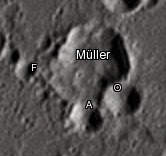Müller (lunar crater)
 Apollo 16 image | |
| Coordinates | 7°36′S 2°06′E / 7.6°S 2.1°E |
|---|---|
| Diameter | 24 × 20 km |
| Depth | 2.0 km |
| Colongitude | 358° at sunrise |
| Eponym | Karl Müller |
Müller is a lunar impact crater. It was named after Austrian astronomer Karl Müller.[1] It is located in the highlands near the center of the Moon, in the center of the triangle formed by the much larger craters Albategnius, Ptolemaeus, and Hipparchus. To the east lies Halley, while to the northwest is Gyldén.
The rim of this crater is irregular and slightly oblong, with the long dimension oriented along a north–south axis. The southeastern rim is notched by two smaller craters identified as Müller A and Müller O.
Perhaps the most distinctive feature of this crater is the peculiar linear formation of small craters that starts at the southern edge of Müller's rim. These follow a line to the northwest, tangential to the rim of Ptolemaeus.

Satellite craters[edit]
By convention these features are identified on lunar maps by placing the letter on the side of the crater midpoint that is closest to Müller.
| Müller | Latitude | Longitude | Diameter |
|---|---|---|---|
| A | 8.2° S | 2.1° E | 10 km |
| F | 7.8° S | 1.5° E | 6 km |
| O | 7.9° S | 2.4° E | 11 km |
References[edit]
- ^ "Müller (lunar crater)". Gazetteer of Planetary Nomenclature. USGS Astrogeology Research Program.
- Andersson, L. E.; Whitaker, E. A. (1982). NASA Catalogue of Lunar Nomenclature. NASA RP-1097.
- Bussey, B.; Spudis, P. (2004). The Clementine Atlas of the Moon. New York: Cambridge University Press. ISBN 978-0-521-81528-4.
- Cocks, Elijah E.; Cocks, Josiah C. (1995). Who's Who on the Moon: A Biographical Dictionary of Lunar Nomenclature. Tudor Publishers. ISBN 978-0-936389-27-1.
- McDowell, Jonathan (July 15, 2007). "Lunar Nomenclature". Jonathan's Space Report. Retrieved 2007-10-24.
- Menzel, D. H.; Minnaert, M.; Levin, B.; Dollfus, A.; Bell, B. (1971). "Report on Lunar Nomenclature by the Working Group of Commission 17 of the IAU". Space Science Reviews. 12 (2): 136–186. Bibcode:1971SSRv...12..136M. doi:10.1007/BF00171763. S2CID 122125855.
- Moore, Patrick (2001). On the Moon. Sterling Publishing Co. ISBN 978-0-304-35469-6.
- Price, Fred W. (1988). The Moon Observer's Handbook. Cambridge University Press. ISBN 978-0-521-33500-3.
- Rükl, Antonín (1990). Atlas of the Moon. Kalmbach Books. ISBN 978-0-913135-17-4.
- Webb, Rev. T. W. (1962). Celestial Objects for Common Telescopes (6th revised ed.). Dover. ISBN 978-0-486-20917-3.
- Whitaker, Ewen A. (1999). Mapping and Naming the Moon. Cambridge University Press. ISBN 978-0-521-62248-6.
- Wlasuk, Peter T. (2000). Observing the Moon. Springer. ISBN 978-1-85233-193-1.
